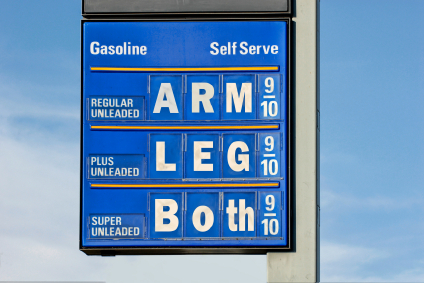Cross-posted from the Wonk Room.
The mounds of snow blackened by auto exhaust have barely melted in Washington, D.C, yet the Energy Information Administration’s Short Term Energy Outlook already predicts that average gas prices “will exceed $3 per gallon” in coming months:
Average U.S. pump prices likely will exceed $3 per gallon at times during the forthcoming spring and summer driving season.
EIA projects gasoline consumption will begin to show modest, but consistent, increases over the previous year, growing by 60,000 bbl/d in 2010 and 70,000 bbl/d in 2011.
In other words, there will be a gasoline price increase of 17 percent compared to summer 2009, even though consumption will only increase by six-tenths of a percent. It means that American drivers will spend an additional $174 million per day on gasoline this summer compared to last year. This could be as much as $16 billion more during the months of June, July, and August. Total daily spending on gasoline this summer could be more than $1 billion per day.
The higher gasoline prices reflect higher oil prices.
EIA expects WTI prices to average above $80 per barrel this spring, rising to an average of about $82 per barrel by the end of the year and to $85 per barrel by the end of 2011.
This will mark a rise in crude oil prices from a $39 per barrel in February 2009 to $82 by the end of 2010 – a 110 percent increase in two years. Oil prices have already closed above $80 this week.
Higher gasoline prices are like a tax on consumers – they pay more for the same amount of product, with the additional funds enriching big oil companies and foreign oil suppliers.
Since one of every four barrels of oil comes from nations that the State Department classifies as “dangerous or unstable,” more oil consumption and higher prices further enriches these states. And a $1 increase in oil prices provides an additional $1 billion dollars to the Iranian government – even though the U.S. buys no oil from it. This can only help Iran incite unrest and attacks in Iraq and elsewhere.
Short-Term Energy Outlook, March 2010:

EIA also predicts an increase in U.S. coal consumption compared to 2009.
Anticipated increases in electricity demand and higher natural gas prices will contribute to modest growth in coal-fired generation in 2010 and 2011. Forecast coal consumption in the electric power sector increases by about 3 percent in 2010, though staying under 1 billion short tons. EIA projects coal consumption in the electric power sector will increase by 1.6 percent in 2011.
And with more oil and coal consumption comes higher levels of carbon dioxide pollution after several years of decrease due to the 2007-2009 recession.
Projected improvements in the economy contribute to an expected 1.5-percent increase in CO2 emissions in 2010. Increased use of coal in the electric power sector and continued economic growth, combined with the expansion of transportation-related petroleum consumption, lead to a 1.2-percent increase in CO2 emissions in 2011. However, even with increases in 2010 and 2011, projected CO2 emissions in 2011 are lower than annual emissions from 1999 through 2008.
Carbon Dioxide Emissions Growth Chart:

Clearly, efforts to reduce oil dependence, coal burning, and global warming pollution cannot begin a moment too soon. The bipartisan American Clean Energy and Security Act, passed by the House of Representatives last summer, would cut oil use by at least 600,000 barrels per day by 2020. It’s the Senate’s turn to pass comprehensive bipartisan clean energy legislation that reduces oil dependence. Senators who care about Americans’ pocket books, national security, and a healthy future must join efforts by Senators John Kerry (D-Mass.), Lindsey Graham (R-S.C.), and Joe Lieberman (I-Conn.) to solve these problems. We can’t afford to wait much longer.



